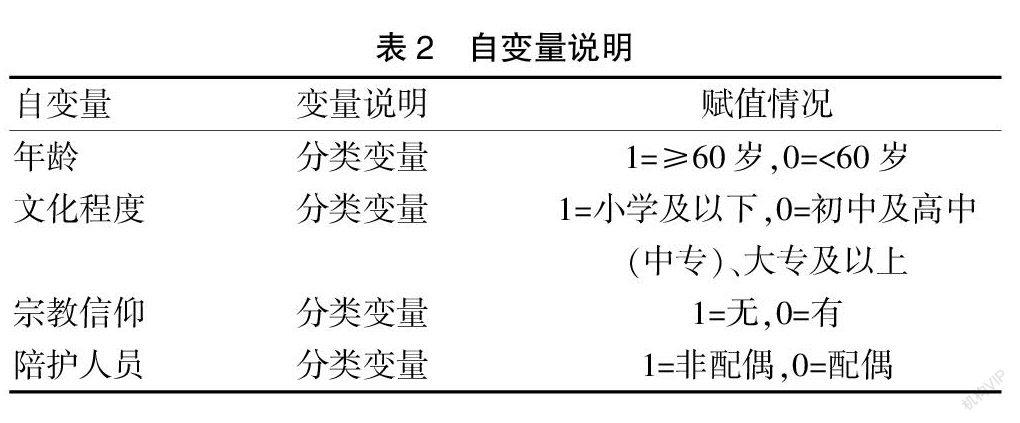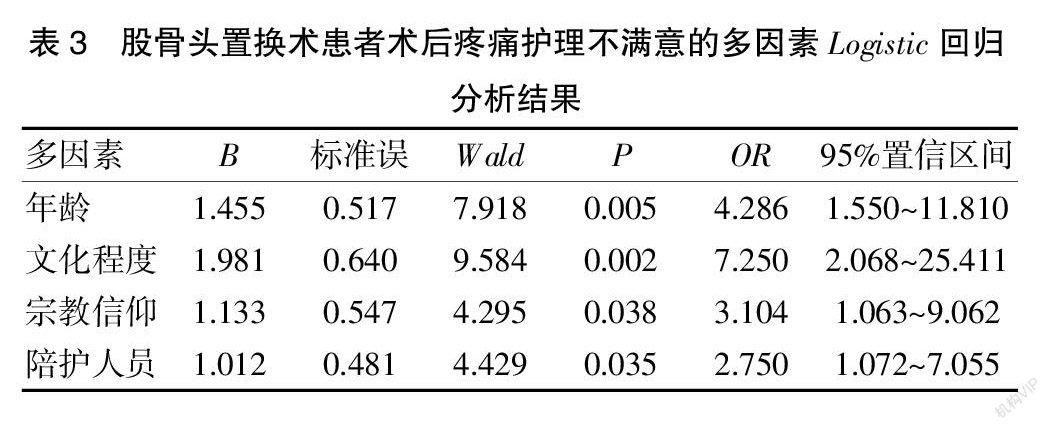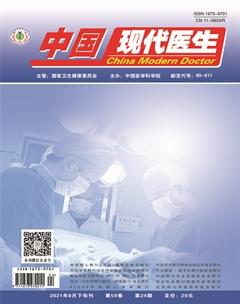股骨头置换术患者术后疼痛状况及满意度相关因素分析
许侃娜 武中庆 沈琰 姚婧婧 沈国美 郑涛



[摘要] 目的 观察股骨头置换术患者术后疼痛状况及疼痛护理满意度相关因素。 方法 选择2018年5月至2020年5月,在我院行股骨头置换术治疗的106例患者,评估其术后疼痛状况,并给予患者疼痛护理干预。评价106例患者护理满意度,统计患者一般基线资料(性别、年龄、宗教信仰、居住地、经济能力、文化程度、陪护人员、既往手术史,术后药物止痛方式等)。经单因素与多因素分析检验股骨头置换术患者术后疼痛护理不满意的影响因素。 结果 106例患者术后疼痛护理干预后,出现轻度疼痛28例(26.42%),中度疼痛53例(50.00%),重度疼痛25例(23.58%);经疼痛护理后,不满意患者例数26例,发生率为24.53%;经单因素与多因素分析结果表明,年龄≥60岁、文化程度为小学及以下、无宗教信仰、陪护人员非配偶是股骨头置换术患者术后疼痛护理不满意的影响因素(OR>1,P<0.05)。 结论 股骨头置换术患者术后以中度疼痛为主,年龄≥60岁、文化程度低、无宗教信仰、陪护人员非配偶可能会导致患者对术后疼痛护理不满意,临床可据此采取适宜的干预措施,以提高患者的疼痛护理满意度。
[關键词] 股骨头置换术;股骨头坏死;疼痛;康复
[中图分类号] R687.3 [文献标识码] B [文章编号] 1673-9701(2021)24-0172-04
Analysis of related factors of postoperative pain and satisfaction in patients undergoing femoral head replacement
XU Kanna WU Zhongqing SHEN Yan YAO Jingjing SHEN Guomei ZHENG Tao
The First People's Hospital of Huzhou, Huzhou 313000, China
[Abstract] Objective To observe the postoperative pain status of patients with femoral head replacement and related factors of pain nursing satisfaction. Methods From May 2018 to May 2020, 106 patients who underwent femoral head replacement surgery in our hospital were selected. Their postoperative pain was evaluated. And the pain nursing intervention was given. The 106 patients′ nursing satisfaction was evaluated. The patients′ general baseline data (gender, age, religious belief, place of residence, economic ability, education level, accompanying staff, previous surgery history, postoperative medication pain relief methods) were calculated. Single-factor and multi-factor analysis were used to examine the influencing factors of dissatisfaction with postoperative pain care for patients undergoing femoral head replacement. Results Among 106 patients with postoperative pain nursing intervention, 28 cases (26.42%) had mild pain, 53 cases (50.00%) with moderate pain, and 25 cases (23.58%) with severe pain. After 106 patients with postoperative pain nursing intervention, 28 cases (26.42%) had mild pain, 53 cases (50.00%) with moderate pain, and 25 cases (23.58%) with severe pain. After pain care, there were 26 dissatisfied patients, with an incidence rate of 24.53%. The results of single factor and multivariate analysis showed that patients aged ≥60 years old, education level of elementary school and below, no religious beliefs, and non-spouses of the accompanying staff were influencing factors of unsatisfactory postoperative pain nursing of patients undergoing femoral head replacement (OR>1, P<0.05). Conclusion Postoperative femoral head replacement patients mainly have moderate pain. Age≥60 years old, low education level, no religious beliefs, and non-spouse of accompanying staff may cause patients to be dissatisfied with postoperative pain care. Clinically, appropriate intervention measures can be taken accordingly to improve patients′ satisfaction with pain care.

